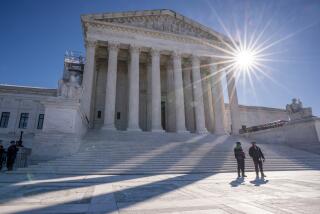Demystified Court Invites a Backlash
- Share via
President Bush’s decision to support a constitutional amendment prohibiting flag- burning may be in some respects questionable, and it exposes him to the charge of playing politics with the flag. Even more questionable, however, was the Supreme Court’s 5-4 ruling declaring the flag-desecration laws of 48 states unconstitutional.
The court’s decision was in some ways reminiscent of the 1973 Roe vs. Wade case, which used a constitutional pretext to strike down all state laws against abortion. That case embroiled the court in controversy that only seems to increase with every passing day. One might have thought this court would at least have avoided making that mistake again--the error of pitting itself against state legislatures across the land.
But in the flag case, Texas vs. Johnson, the court has done it again. This is likely to increase public skepticism about the court, perhaps resulting in a backlash.
A feature of this case--not often true of Supreme Court decisions--is its comparative simplicity. Because people can understand its essential elements, they can be expected to trust their own judgment more than that of the five justices in the majority. One result may be to demystify the court--perhaps to embolden Congress to limit its appellate jurisdiction, which under Article III of the Constitution it has the power to do. In short, the ruling could end up undermining the court’s own authority, much as the Pope could undermine the teaching authority of the Catholic Church if he were to publish an encyclical “discovering” in the text of the Bible a hitherto undetected justification for sacrilege.
In a conversation with Robert H. Bork, whose nomination to the court was rejected by the Senate in 1987, I raised the possibility that the flag ruling might hurt the court more than the flag. “They don’t care,” he said, adding that Justice Antonin Scalia (who voted with the majority) had been showing up at Washington parties waving a flag. Bork was highly critical of the flag ruling, saying it was “incomprehensible” and “wrong in every particular.” He supports the proposed constitutional amendment.
The core of the court’s ruling was that it “discovered” in the First Amendment a justification for striking down all statutes that outlaw flag-burning. “If there is a bedrock principle underlying the First Amendment,” Justice William J. Brennan Jr. wrote for the majority, “it is that government may not prohibit the expression of an idea simply because the society finds the idea itself offensive or disagreeable.”
The problem is that this departs from common sense. The First Amendment protects speech, not “expression,” and flames should not be confused with “ideas.” Millions of people understand this, and as they discover that the law now says otherwise, they are likely to conclude the law is an ass. The point is that the Texas law that was struck down did not prohibit the expression of the idea or ideas that torching the flag was presumably meant to convey--hatred of America, for example. As Bork pointed out, this was expressed at the episode that gave rise to the case. At the 1984 Republican National Convention in Dallas, demonstrators set an American flag on fire while others chanted: “America, the red, white and blue, we spit on you.”
The purpose of protecting the freedom of speech is to permit a contest of views from which truth may emerge. As the court has held since 1942 in its unanimous “fighting words” ruling, “there are certain well-defined and narrowly limited classes of speech, the prevention and punishment of which have never been thought to raise any constitutional problem. Among these are ‘fighting words’--those which by their very utterance inflict injury or tend to incite an immediate breach of the peace . . . Such utterances are no essential part of any exposition of ideas.” If a burning flag does express any idea at all, it surely is one that aims to inflict injury on those who hold the flag dear.
As for the tendency to breach the peace, fist fights provoked by celebrating flag- burners have already been shown on television. Indeed, future flag-burnings could almost certainly be prevented by local police invoking breach-of-the-peace, rather than flag-desecration, statutes.
One may object to the proposed constitutional amendment on the grounds that the Constitution should be changed as infrequently as possible and that a prohibition against flag-burning fits uncomfortably into any Constitution--it is too particular and too concrete. But the problem we have right now is that the Supreme Court itself is constantly “amending” the Constitution. In a kind of surreptitious imperialism, it unpredictably expands the court’s jurisdiction by new constitutional interpretation, thereby limiting the discretion of the states. As a result, our laws lack the essential ingredients of stability and predictability.
Depending on the whim of individual justices, we are from week to week liable to be saddled with novel constitutional principles. And we are burdened with the fiction that the Supreme Court can do no wrong. This is because there is so little that we can do to correct the court’s dicta. But we can amend the Constitution, and if that’s what it takes to send the imperial court a message, so be it.
More to Read
Get the L.A. Times Politics newsletter
Deeply reported insights into legislation, politics and policy from Sacramento, Washington and beyond. In your inbox twice per week.
You may occasionally receive promotional content from the Los Angeles Times.










